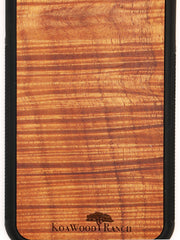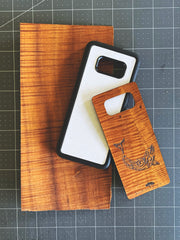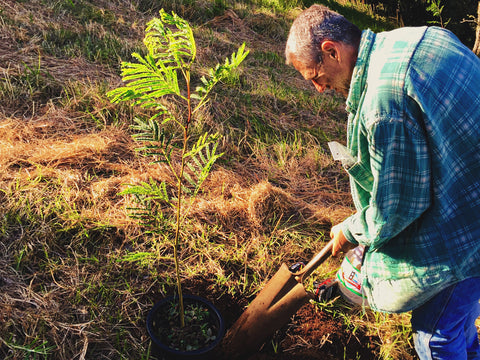What are the Pros and Cons of Wood Phone Case?
Jul 27, 2020
My most exciting acquisition after buying a new phone is deciding on a phone case. For me, the answer is obvious, and that’s because I make my own Koa wood phone cases. For anyone else, however, what to get, may require more consideration. For that reason, I wrote this article with the intent of answering the question, “What are the pros and cons of wood phone cases?"
The pros and cons of wood cases fall under one major advantage and one disadvantage; look vs. price. The primary benefit of wooden phone cases is aesthetics. Mother Nature is by far the best designer. However, the cost of unique and one of kind usually comes at a higher cost.
Having owned a Koa Wood phone case for many years…and the fact that I make wooden cases for our retail shop, I have a few things I can share that will help you consider the pluses and the minuses of owning a wood phone case.
Pros
-
Aesthetics
 Organic design is unique and one of kind. No two wood grain patterns are the same. Unlike mass-produced plastic and alternative cases, wooden cases are made from a slice of a tree that is unmatched by another part of that tree. Like a fingerprint, the natural properties and configuration aren’t duplicated. Therefore, no one can own a wooden phone case like the one that you’ve chosen to own.
Organic design is unique and one of kind. No two wood grain patterns are the same. Unlike mass-produced plastic and alternative cases, wooden cases are made from a slice of a tree that is unmatched by another part of that tree. Like a fingerprint, the natural properties and configuration aren’t duplicated. Therefore, no one can own a wooden phone case like the one that you’ve chosen to own.
-
Worn Wood Looks Good
What I love most about my phone case is that I don’t worry about scratches or dents. In fact, if and when they occur I appreciate the phone even more because it adds character in a way that no synthetic made case can. If you scratch, crack, or chip a plastic phone cover the damage is obvious. However, wood, when it has aged it looks antique. This is consistent with most organic materials like leather. It holds its aesthetic value.
-
Conversation Piece
I’ve never had a phone case more talked about than my Koa Wood phone case. Whether I lay it down at the table during dinner or pull it out to check my newsfeed, people who see it for the first time always comment on it. Words like “beautiful” and “cool,” proceed questions like “Where did you get that from?,” and “How is it made?” For which I take delight in mentioning that I made it.

-
Sustainability - Eco-Friendly
Nowadays more and more of us are making decisions that align with the best interest of our environment. The great thing about purchasing a wood phone case is that the material is regenerative. Therefore, it replaces, in part, the need to commercially manufacture inks and synthetic materials. In addition, if you may find that some of the producers and retailers of wood products often have a give-back component to the purchase of their wood products. Here at the KoaWood Ranch proceeds from the sales of our wood products go right back into the forest conservation efforts. It helps pay for planting, invasive plant species eradication, and protection. Our forest thrives because of customers like you.
-
Comfort and Easy to Handle
What I like about my cover is that it is slim and slides perfectly into my pockets. This is important, some other phone covers have a grip surface on the outside of the cover which causes friction with the fabric of my pockets. This makes it frustrating to easily access the phone if it is ringing or I get a text. The wood and shell I use perfectly work together to ensure I can hold it with comfort so that it doesn’t fall out of my hands, however, there’s no friction sliding it into my pocket.
-
Customizable
Personalization is not typically available for commodity phone
-
Connection to Real World
We are surrounded by a manufactured world. As I type on the keyboard I’m having a virtual experience looking at a screen, the clothes I feel on my body are made with lycra and synthetics, I hear in the distance my electronic Roomba sweeping the floor. I appreciate the modern world as much as anybody else. In fact, I couldn’t be writing this article if not for the cell phone the need for its cover. But with all that said, I also like being reminded of what only mother nature can create. It keeps me connected and grounded to what really feeds my soul - nature.
Cons
-
Expensive
Perhaps the biggest resistance to purchasing a wood phone case is the price. Phone cases average between $15 and $45. Cheap commodity cases lie on the lower end of the scale and wooden phone cases around the $35-$45 range, even more for inlays or custom laser engraving.
Unlike high production made phone covers (with molds and repeatable designs), wood phone covers require more labor. The wood has to be sourced, milled, laser cut (or CNC) and etched before they are manually assembled. The additional labor raises the production cost. In addition, some makers like myself only produce small batches adding to the complexity of production.
Given the quality and value of a truly unique art piece, most if not all wooden phone case owners will tell you the cost was worth every penny.
-
Susceptible to Moisture and Sun Damage
Most things organic are susceptible to decay. Wood is particularly sensitive to water, moisture, and direct sunlight. Although most wood phone cases are protected with some kind of sealant, be it lacquer or wax, the sealant can break down in the presence of moisture or direct sunlight. This can cause warping, and/or the undoing of any adhesives. Protecting your phone case from the elements is key to ensuring that it lasts for a long time. For more information and tips on how you can care for your phone cover read Are Wooden Phone Cases Durable?
-
Susceptible to Dents and Scratches
Woods come in varying hardnesses. But regardless of what type of wood, it will be susceptible to both dents and scratches. However, what at first glance is perceived as a “con” can actually be perceived as a benefit if you appreciate the fact that wood that is worn has a warm antique feel. Personally, I’ve had my wood cover for many years and it’s had its share of falls, drops, and sun exposure. Nonetheless, I appreciate its unique character. I think it looks cool.
There are more “pros” than “cons”
Although affordability will play a big factor when choosing the right phone cover for you, there’s a good case (no pun intended) to make in favor of getting a wooden phone case and paying the premium. When evaluating the benefits vs. hindrances, it’s clear to me that wooden cases provide a proposition that no other option offers; beauty, originality, and an unmatched eco component.




